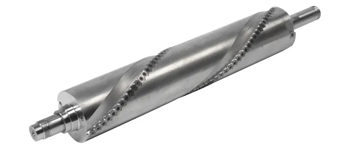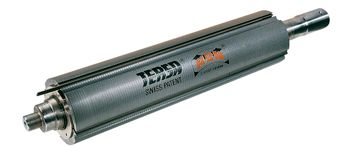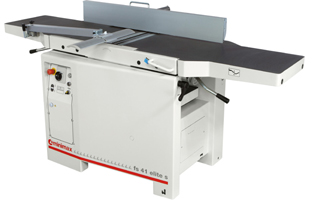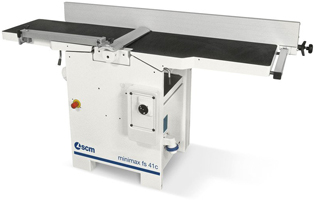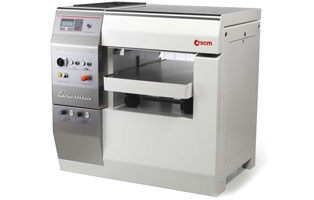Elite Metal Tools Articles
Industry news, tips, and updates on all things Elite Metal Tools
Tersa vs. Xylent Cutter Heads: An Expert Opinion
This article was written by Sam Blasco, an expert woodworking instructor and team member at SCM Group—an affiliate partner to Elite Metal Tools. Sam has over 20 years of experience in professional woodworking, growing his own business from the back of a van to a full size production shop in Texas.
For cutter heads, it is kind of a “Great taste!... Less Filling!” debate. Both Tersa and Xylent are great systems. If you are more of an artisan shop Tersa probably has the edge If you are more of a production shop, the advantage probably falls to Xylent.
I, personally, feel the Tersa knife system is the superior system on the market. The segmented heads get massive amounts of buzz because most folks are coming from a basic straight knife system, and often use dull knives (due to the pain of having to set them they let them go far too long between sharpenings). So compared to the segmented systems it is a no brainer. I have worked with a Tersa machine since the early 90s when I was foreman in large production facility, where we had a Tersa head on our 24" planer and 20" jointer. We also had a 24" planer with the Shellix Head, that was used only for hogging rough lumber, which it excelled at, but we didn't use it for final passes because of the distinctive pattern it left behind, some call this "ghosting". This could have been partially due to the amount of use it got, but the Tersa head definitely left behind a better finish quality and feel, which is mainly what we used it for. And even now, every different segmented head I have tried I can always tell a board was cut with one due to this ghosting effect. I fell in love with Tersa then and have opted for it on all my machines since. Even compared to the Shellix heads and the many spiral head copy cats since Shellix came out. They both do a nice job, but Tersa is quicker to change and they offer different types of knives so you can really couple the right knife to the species of wood you are working with. Since I tend to work with Cherry, Walnut, Oak, etc. I like to switch to HSS knives for my final passes, while hogging down to the final passes with M42 steel. Since a knife change happens in less than 2 minutes this is very easy to do. You would be hard pressed to find negative comments out there about Tersa.
The Tersa cutterhead is manufactured in Switzerland, then sold under license to premium machinery suppliers such as Minimax, SCM, Martin and others. Tersa is standard on all Minimax jointers and planers for the US market. Tersa knives are double-sided and disposable. They lock into place by centrifugal force—no special tools required. All you do is start the machine and the knives automatically lock themselves in. No knife setting ever! Tersa also has several advantages over helical/spiral or other "Silent" systems.
Speed — Helical heads have dozens of inert knives and require a torque wrench to change, so rotating/replacing inserts is definitely not fast. Tersa knives change in seconds without any special tools.
Safety — While it's possible to improperly tighten an insert tooth on any helical head or some of the other "quick-change" systems out there, Tersa knives are designed to never come loose. The faster the Tersa head rotates, the more securely the knife locks into place.
Quietness — Tersa knives have a low-projection profile and are extremely quiet. In fact, they are typically 10dB quieter than any standard head and nearly as quiet as other helical or "Silent" heads, 4dB more.
Economical — Much cheaper to replace one cutting edge of your Tersa system than on most helical heads. There are plenty of vendors online, including Amazon. Find your best deal. You aren't locked into buying from just one supplier with Minimax.
Options — Unlike helical heads, where your only choice is carbide, Tersa knives are available in at least 8 different alloys and grinds, including HS/S, M42 Cobalt, Chrome steel, and, now, specially coated.
Finish Quality — Carbide inserts are durable but inferior to High-Speed Steel in finish quality. Though spiral or "Silent" heads will go long periods without a knife change, a segmented head like that will never give you the finish that a straight knife like Tersa can. Tersa gives you the option to choose the grind and alloy best suited to your particular workpiece, which is not an option with insert-type heads. Tersa knives can also be loosened and slid over slightly to take care of any knife damage, saving you time and money. Or, mix and match alloys in the same head to get the best combination of finish quality and longevity. You would be hard pressed to find a negative comment about Tersa out there.
Recommended uses for the four main Tersa knife types:
• Chrome: Aspen, Douglas-fir, Pine, Poplar.
• HSS: Best for all around use. Maple, Cherry, Walnut, etc.
• M42: For tougher applications. Less likely to chip the cutting edge than HSS. Oak, Ash, Hickory, etc.
• Solid Carbide: Most durable, reduced finish quality, recommended for teak, exotic hardwoods, laminated woods, dirty material, glue lines.
